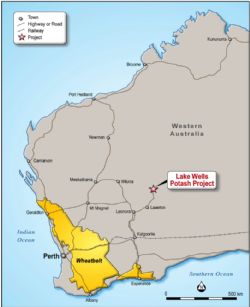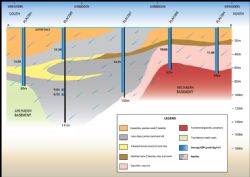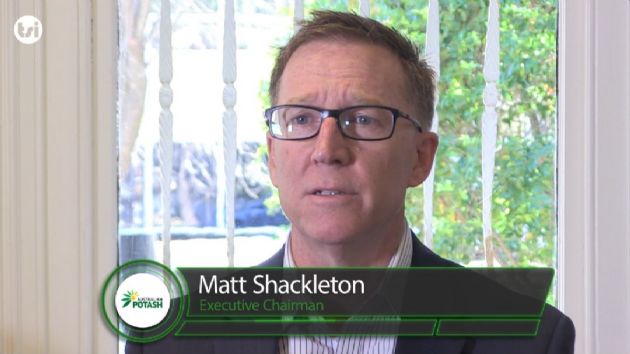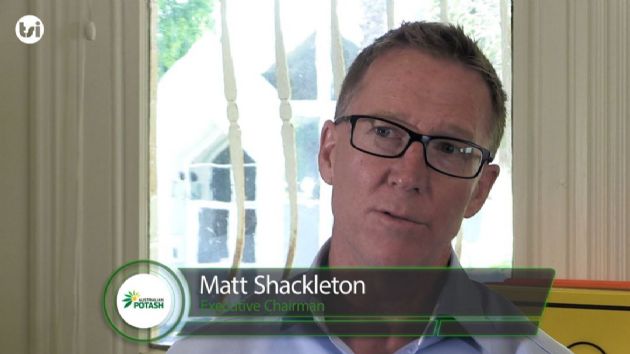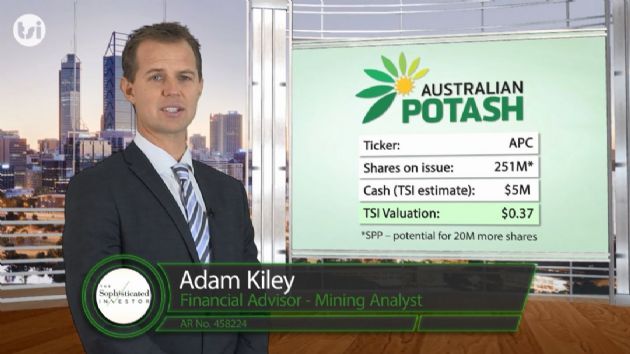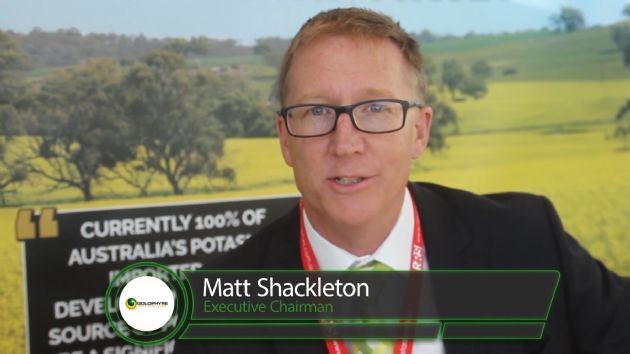
Quarterly Activities Report
Perth, Oct 15, 2015 AEST (ABN Newswire) - Goldphyre Resources Limited ( ASX:GPH) announce the Quarterly Activities Report and Lake Wells Potash Project with significant highlights.
ASX:GPH) announce the Quarterly Activities Report and Lake Wells Potash Project with significant highlights.
- Drilling program completed comprising 1,227 metres of air-core across 17 holes to depths up to 141 metres, and 18 shallow auger holes
- High grades of potassium (K) and sulphate of potash (SOP) recorded not just from drill holes on the lake surface but also from surrounding lake margins
- Significant depth extensions to previous near-surface pit samples was demonstrated, down to depths of 141 metres
- 5 of the 17 holes did not intercept bedrock, with 3 of these reaching depths over 135 metres, indicating the presence of a deep, high grade K palaeochannel
- The Project's location, access to infrastructure and strong results make Goldphyre confident that forward work programs will further strengthen the case towards developing a Project that can address the SOP needs of Australian farmers
Corporate
- Finalisation of placement of shares to existing and new sophisticated investors raising $1,000,000
LAKE WELLS POTASH PROJECT
Goldphyre Resources' 100% owned Lake Wells Potash Project is a brine-hosted sulphate of potash (SOP) project located in the Eastern Goldfields region of Western Australia, which is aiming to supply the Australian domestic demand for SOP. Currently Australia imports 100% of all potash used, estimated at 500,000 - 600,000 tonnes per annum.
During the quarter, Goldphyre completed an air-core (AC) drilling campaign at the Project, comprising 1,227 metres across 17 holes (Figure 2 in link below). An additional 18 shallow auger holders were also completed. The air-core holes were drilled to depths of up to 141 metres.
The drilling program was the Company's first focussed drill program testing the brine potash potential at the Project. The program was designed to test the presence and consistency of high-grade potash in brine:
- At significant depths in the deep regolith recognised at Lake Wells from previous explorer's work and recent Goldphyre (non-potash) drill coverage; and,
- Beneath transported sand and dune areas adjacent to the salt lake margins.
The program achieved the following:
- It confirmed near-surface brine pit sampling results continue to depth, with broad downhole intercepts of high-grade potash to +130 metres (Figure 2 in link below);
- It confirmed strong, high-grade potash grades from AC drill holes on sites adjacent to the lake surface. Over 50% of the drill holes were completed over a 50m - 400m range from the salt lake surface;
- It generated very encouraging indicative brine flow test data from low pressure airlifting, ranging up to 2 litres per second, from drill holes both on the lake surface and adjacent surrounds;
- It has given a more thorough understanding of regolith, palaeochannel form and the weathered Archaean bedrock profile; and,
- It has provided a sound foundation of drill, sample and analytical data to commence resource-modelling work.
Lithology types (Figure 3 in link below) logged included surficial or near surface evaporite and sand/silt, silcrete+/-laterite, common lake clays with some well-sorted sand units, puggy lacustrine clays with minor sand/silt and Archaean basement rocks including transitional porphyry, granite, ultramafic and amphibolite types. It is encouraging to note significant potash brine grades were also encountered in the weathered basement at and near the bottom of some holes.
Isolated lower value potassium in brine concentrations were returned from a small number of samples from some intervals in some of the AC drill holes (approximately 2.5% of all samples). A number of factors may have contributed to this decrease in concentrations, warranting further investigation, which is currently being conducted.
The Company is aware of recent reports of discrepancies in potassium analyses between ALS Environmental Division, and other assay laboratories.
For the assaying of samples collected during the July/August 2015 air-core and auger campaign at Lake Wells1, Goldphyre used as the primary laboratory ALS Environmental, part of the ALS Laboratory Group. MPL Laboratory was engaged as the secondary laboratory for duplicate analysis.
Goldphyre has undertaken re-analyses of remnant brine samples and additional QA/QC. Samples were sent to Perth laboratories ALS Ammtec ('ALSA', primary laboratory), Bureau Veritas Minerals ('BV', secondary or 'check' laboratory), and ALS Environmental ('ALS-E') for re-analysis. Reference standard solutions were procured and analysed by all three laboratories.
The results of the repeat analyses and the original data set are summarised in Table 1. Inter-laboratory duplicate comparisons are summarised in Table 2. The original analysis of the brine samples reported potassium concentrations higher than the re-analysis results. The reasons for the discrepancies between potassium concentrations across laboratories are unknown.
ALS-E report that the analytical method used by them is best suited to trace analysis and designed with sensitivity in non-challenging matrices, and suggest that samples submitted for re-analysis may have been compromised by the presence of solids in the sample containers. They further indicate that the presence of solids may lead to the concentration of cations (of which potassium is one) in solution changing over time. 23 duplicate samples that were sent to ALS-E for re-analysis, report a potassium concentration difference of 7.6% (ALS-E initial results higher), which is potentially a reflection of this change in concentration of cations over time.
ALS Global report acceptable experimental error for assays of this nature is +/- 10%.
FUTURE ACTIVITIES
Forward fieldwork will be focussed primarily on the Lake Wells Potash Project, with programs designed around addressing the more critical aspects of successful salt lake brine projects. Grade, permeability, recharge parameters, and tenure all have been shown to be relevant parameters in overseas brine potash developments, and it is these critical factors that the Company is looking to directly understand.
In the immediate term, this will entail work designed to identify, and develop an understanding of, sufficient permeable material (for example sands, gravels & other porous and fractured lithologies) that could support high volume extraction of brines.
The first step in this module of work is a ground based seismic survey across the Project, which is scheduled for October 2015. It is anticipated that the results of this survey will direct planning for the next drilling campaign, which will be designed around the recovery of core.
The recovery and analysis of this core will target the specific yield of the potential resource, which is, among other parameters, a function of the permeability of the ground. Ultimately, the Company is working towards identifying what the Lake Wells Potash Project can deliver in terms of SOP production.
Minerals Sampling Results
The Company is pleased to report composite mineral sample results from the recently completed reconnaissance air-core (AC) drill program (Figure 1, Appendix 1 in link below). While the primary focus of the July/August 2015 drilling program was the brine potash, selective mineral sampling was completed to evaluate the metal potential of the transported sediments. The mineral sampling returned a maximum gold value of 51 ppb Au from PLAC006 (20-21m EOH). The low metals prospectivity of the sediments sampled is not surprising, given the hole placement and lithologies encountered.
CORPORATE
Capital Raising
The Company completed the second tranche of a placement of ordinary shares ( ASX:GPH) to existing and new sophisticated investors on 7 August 2015.
ASX:GPH) to existing and new sophisticated investors on 7 August 2015.
Priced at 3.2 cents per share including a free attaching listed option ( ASX:GPHO) exercisable at 8 cents at any time before 30 September 2016, the placement raised a total of $1,000,000 before costs.
ASX:GPHO) exercisable at 8 cents at any time before 30 September 2016, the placement raised a total of $1,000,000 before costs.
The placement was effected in two tranches, with the first tranche of 17.1 million shares settled on Friday 3 July 2015, and the second tranche of 14.1 million shares and 31.25 million options settled after the Company's General Meeting held on 7 August 2015.
Cash Position
At 30 September 2015, the Company had cash reserves of $746,000.
To view the full report including tables and figures, please visit:
http://media.abnnewswire.net/media/en/docs/ASX-GPH-737313.pdf
About Australian Potash Ltd
Australian Potash Limited (ASX:APC) is an ASX-listed Sulphate of Potash (SOP) developer. The Company holds a 100% interest in the Lake Wells Potash Project located approximately 500kms northeast of Kalgoorlie, in Western Australia's Eastern Goldfields.
Following the release of a Scoping Study in 2017, APC has been conducting a Definitive Feasibility Study (DFS) into the development of the Lake Wells Potash Project. The Company is aiming to release the findings of the DFS in H2 2019.
The Lake Wells Potash Project is a palaeochannel brine hosted sulphate of potash project. Palaeochannel bore fields supply large volumes of brine to many existing mining operations throughout Western Australia, and this technique is a well understood and proven method for extracting brine. APC will use this technically low-risk and commonly used brine extraction model to further develop a bore-field into the palaeochannel hosting the Lake Wells SOP resource.
A Scoping Study on the Lake Wells Potash Project was completed and released on 23 March 2017. The Scoping Study exceeded expectations and confirmed that the Project's economic and technical aspects are all exceptionally strong, and highlights APC's potential to become a significant long-life, low capital and high margin sulphate of potash (SOP) producer.
| ||
|




